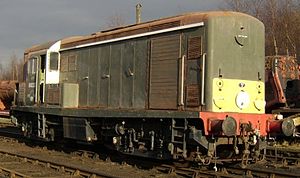British Rail Class 15

Sole surviving Class 15 no D8233 seen at Baron Street Loco Shed, East Lancashire Railway, February 2006
|
|||||||||||||||||||||||||||||||||||||||||||||
|
|||||||||||||||||||||||||||||||||||||||||||||
|
|||||||||||||||||||||||||||||||||||||||||||||
|
|||||||||||||||||||||||||||||||||||||||||||||
|
|||||||||||||||||||||||||||||||||||||||||||||
| Type and origin | |
|---|---|
| Power type | Diesel-electric |
| Builder | British Thomson-Houston at Clayton Equipment Company |
| Build date | 1957–1961 |
| Total produced | 44 |
| Specifications | |
|---|---|
| Configuration: |
|
| • Whyte | Bo-Bo |
| • UIC | Bo-Bo |
| Gauge | 4 ft 8 1⁄2 in (1,435 mm) standard gauge |
| Wheel diameter | 3 ft 3 1⁄2 in (1.003 m) |
| Minimum curve | 3.5 chains (70.41 m) |
| Wheelbase | 31 ft 0 in (9.45 m) |
| Length | 42 ft 0 in (12.80 m) |
| Width | 9 ft 2 in (2.794 m) |
| Height | 12 ft 6 in (3.810 m) |
| Loco weight | 69 long tons (70 t; 77 short tons) |
| Fuel capacity | 400 imp gal (1,800 L; 480 US gal) |
| Prime mover | Paxman 16YHXL |
| Displacement | 78.4 L (4,780 cu in) |
| Generator |
Main : BTH RTB10858 Auxiliary : BTH RTB7420 |
| Traction motors | 4 x BTH 137BZ, nose suspended, with single reduction gear |
| Cylinders | 16 |
| Cylinder size |
bore: 7 in (178 mm) stroke: 7 3⁄4 in (197 mm) |
| Transmission | Diesel electric |
| MU working | ★ Blue Star |
| Train brakes | Vacuum |
| Performance figures | |
|---|---|
| Maximum speed | 60 mph (97 km/h) |
| Power output |
Engine: 800 hp (597 kW) At rail: 627 hp (468 kW) |
| Tractive effort | Maximum: 37,500 lbf (167 kN) |
| Brakeforce | 31 long tons-force (310 kN) |
| Career | |
|---|---|
| Operators | British Railways |
| Numbers | D8200–D8243 |
| Axle load class | RA 4 |
| Retired | 1968–1971 |
| Disposition | 1 preserved, remainder scrapped |
The British Rail Class 15 diesel locomotives, also known as the BTH Type 1, were designed by British Thomson-Houston, and built by the Yorkshire Engine Company and the Clayton Equipment Company, between 1957 and 1961.
Following the British Railways Modernisation Plan, ten of the class were ordered for evaluation under the 'pilot scheme'. Like other locomotives designed to the 'Type 1' specification, they were intended for use on local freight and empty coaching stock trains.
The design and manufacture was a collaboration between several companies. BTH (the main contractor) provided electrical equipment, Paxman supplied the power units, and Clayton supplied bogies and superstructure, with the frame construction and final assembly taking place at Yorkshire Engine's Sheffield works. These ten locomotives, numbered D8200–D8209, entered service between November 1957 and November 1958.
The design showed sufficient promise for a repeat order for 34 more locomotives to be placed soon afterwards. These locomotives, numbered D8210–D8243 and built by Clayton at Hatton, Derbyshire, were delivered between October 1959 and February 1961.
The first ten locomotives were delivered to the London Midland Region's Devons Road depot in Bow, East London, where they were evaluated against the contemporary North British Type 1 and English Electric Type 1 designs. Soon, however, the entire class was allocated to depots on the Eastern Region, where they remained until withdrawal. The second block of ten was originally allocated to March depot in East Anglia, however due to the Clean Air Act 1956 the locomotives were quickly re-allocated to East London, allowing the replacement of steam locomotives in that area. Thereafter, the type was allocated exclusively to Stratford, Finsbury Park and Ipswich depots.
...
Wikipedia
